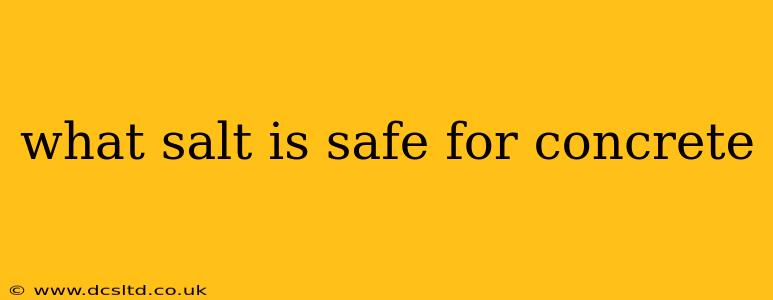Winter's icy grip can make even the sturdiest driveway treacherous. De-icing salt seems like the obvious solution, but not all salts are created equal. Using the wrong type can severely damage your concrete, leading to costly repairs down the line. This guide will delve into which salts are safe for concrete and which ones you should avoid at all costs. We'll also address common questions surrounding concrete and de-icing.
What Kinds of Salt Damage Concrete?
Before we discuss safe alternatives, let's understand why some salts are detrimental to concrete. The primary culprit is sodium chloride, or common table salt. While effective at melting ice, sodium chloride's high solubility leads to several issues:
- Chemical Reaction: Sodium chloride accelerates the chemical reaction that breaks down the cement paste within concrete, leading to weakening and eventual crumbling.
- Scaling and Spalling: Repeated freeze-thaw cycles, exacerbated by the presence of sodium chloride, can cause the surface of the concrete to scale and spall, creating unsightly damage and compromising structural integrity.
- Corrosion of Reinforcing Steel: If your concrete contains reinforcing steel (as most driveways and sidewalks do), sodium chloride can accelerate corrosion, significantly weakening the structure.
What Salts Are Safe for Concrete?
Fortunately, there are safer alternatives to sodium chloride for de-icing your driveway. These options minimize the risk of damage to your concrete:
-
Calcium Chloride: This salt is generally considered a safer option than sodium chloride. It melts ice at lower temperatures and is less corrosive to concrete. However, it's still crucial to use it sparingly and to rinse away any excess after the ice has melted. Calcium chloride can be more expensive than sodium chloride.
-
Potassium Chloride: This is another relatively safe option that's less damaging to concrete than sodium chloride. It's also environmentally friendly, with lower impacts on vegetation and waterways. It is typically more expensive than sodium chloride but less expensive than calcium chloride.
-
Magnesium Chloride: Similar to potassium chloride, magnesium chloride offers a good balance of ice-melting effectiveness and lower impact on concrete compared to sodium chloride. It's also less likely to harm plants.
-
Sand or Kitty Litter: These aren't salts, but they are excellent options for increasing traction on icy surfaces. They won't melt the ice, but they provide grip to prevent slips and falls. This is the safest option for your concrete.
Is Rock Salt Safe for Concrete?
Rock salt is primarily sodium chloride, so the answer is no, it's not safe for concrete in the long term. While it's readily available and inexpensive, the long-term damage it inflicts outweighs its short-term benefits.
How Much Salt Should I Use?
Using excessive amounts of any de-icing salt, even the safer alternatives, can still damage your concrete. Always follow the manufacturer's instructions on the packaging. It's better to apply a smaller amount more frequently than to apply a large amount all at once.
Can I Use Vinegar to De-Ice Concrete?
Vinegar is a mild acid and can potentially damage your concrete over time, though the effect is typically less severe than with sodium chloride. It's generally not recommended as a primary de-icing agent for concrete.
What are the Best Practices for De-icing Concrete?
- Prevention: Shovel snow as soon as it falls to prevent ice from forming.
- Less is More: Use the minimum amount of de-icing salt necessary to do the job.
- Rinsing: Rinse away any excess salt after the ice has melted to minimize damage.
- Alternatives: Utilize sand or kitty litter for improved traction.
- Regular Inspections: Periodically inspect your concrete for any signs of damage.
By choosing the right de-icing salt and following best practices, you can protect your concrete driveway from winter's harsh effects and maintain its structural integrity for years to come. Remember, prevention and careful application are key!
